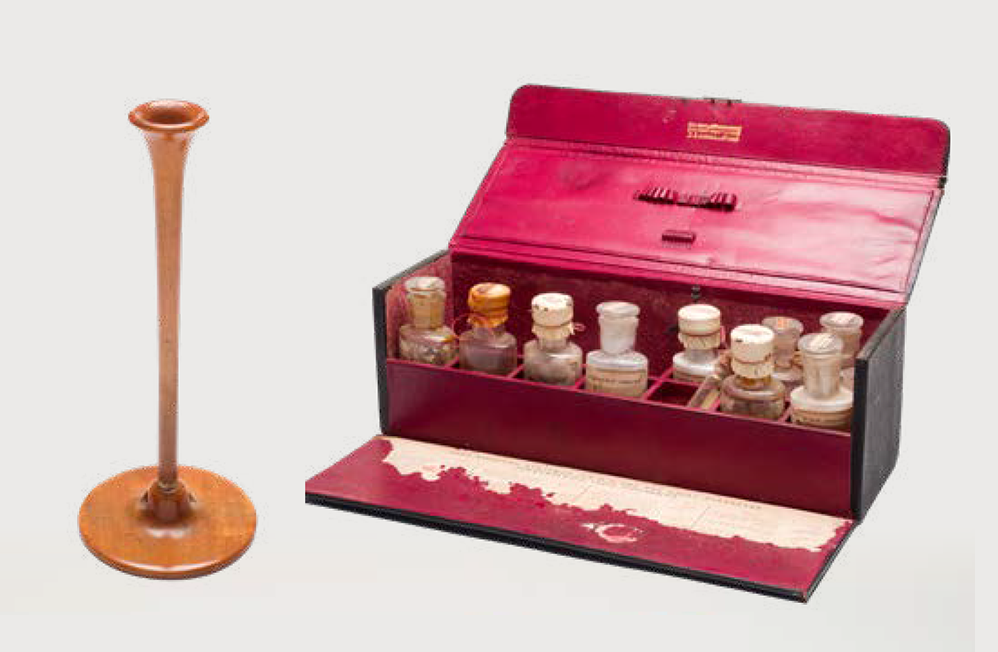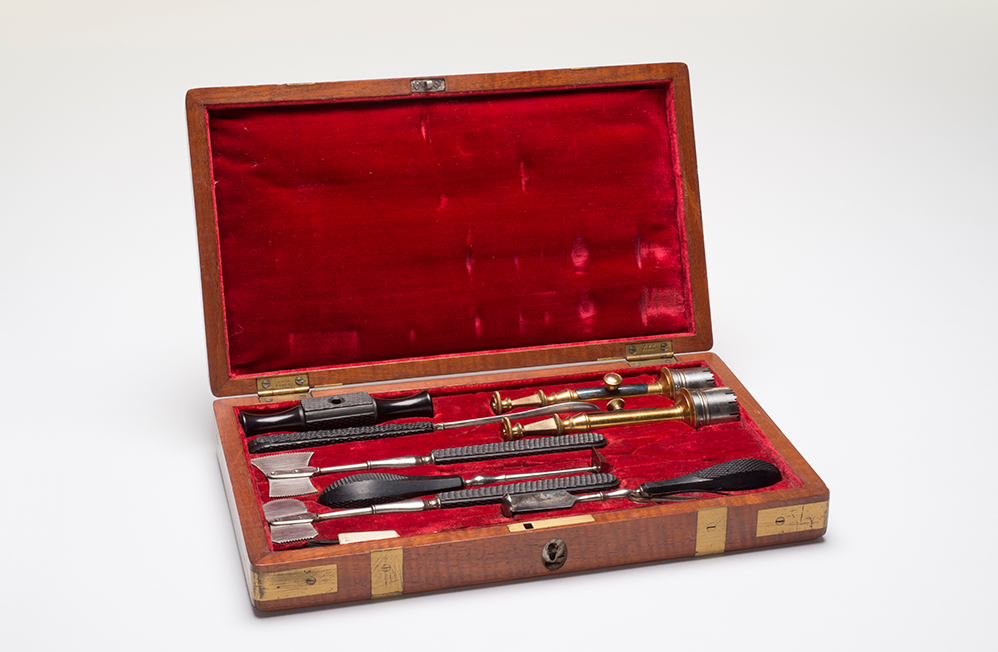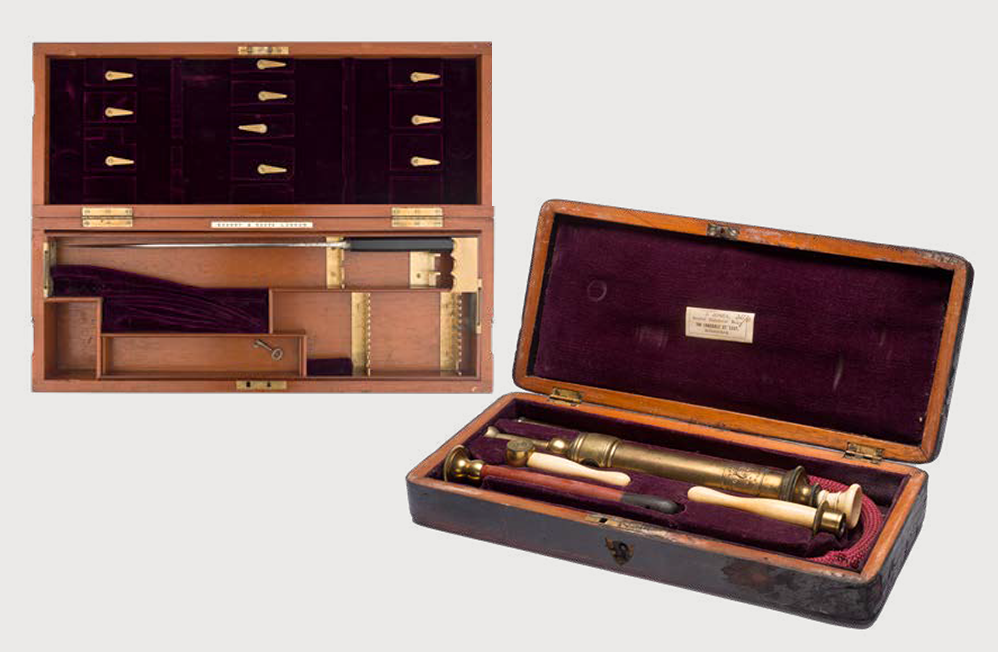
Tools of Trade, a fascinating exhibition of medical artefacts from the mid-late nineteenth century was on display to members at AMA Victoria House in Parkville. The exhibition opened on 8 November 2022 and ran until March 2023.
Members can view the Medical History collections, including parts of the AMA Collection, online at: https://collections.mdhs.unimelb.edu.au/explore
STORY BY VANESSA MURRAY
The exhibition, Tools of Trade, is a carefully curated selection of more than 20 everyday objects that doctors used in conducting their medical practice such as stethoscopes, medical kits and microscopes. Many were used by early doctors of the Port Phillip District and date to the mid-late nineteenth century.
“These items are significant as they give us insight into the day-to-day lives of doctors and how they carried out their profession, but also reflect science and technology of the time,” says curator Jacqueline (Jacky) Healy.
The monaural stethoscopes on display might look outmoded to us now, but at the time they were state of the art – and not without controversy.
“Before the invention of this type of stethoscope, doctors would roll up a paper tube and use it as a funnel. Many doctors thought this was quite adequate and didn’t like the new devices. We selected these for inclusion as the stethoscope is an enduring symbol of the physician’s trade,” explains Jacky.
Made primarily of wood, with one end larger than the other and a hollow cavity in between, monaural stethoscopes enabled a physician to listen to a patient’s chest without having to place their ear improperly close (important especially regarding women patients) and are the precursor to today’s binaural stethoscope design.
And then there are the amputation kits. While older versions are ornate and crafted from materials like wood, bone, and ivory, more later versions are far more utilitarian – either purely metal, or with a metal blade which could be detached from its handle.
“This shift in form from decorative to utilitarian reflects a hugely important development in medical science of the time – germ theory. They show us that people began to understand that germs existed and posed risks, and that medical instruments needed to be made of non-porous materials that could be thoroughly and properly cleaned,” says Jacky.
Similarly, the Burroughs & Wellcome medical kit on display shows how doctors conducted their business at this time, and how health care was accessed in society.
“Hospitals were for the poor – if you were more well to do the doctor came to you. Supplies like these were an essential part of a colonial era doctor’s kit, as they travelled to their patients and needed to be able to prepare and dispense prescriptions on the spot.”
The items in Tools of Trade are from the much larger AMA Collection, which was amassed and retained by AMA Victoria and then loaned to the University in 1994 when its museum closed and bequeathed to the University of Melbourne in 2011. It contains more than 5,000 artefacts, including instruments, photographs and correspondence, and is still be catalogued by Jacky, students and colleagues.
The exhibition and the AMA Collection are also reflective of wider histories – those of western medicine, colonisation, the AMA and the University of Melbourne.

Left: This foetal stethoscope dates from circa 1890. Made from wood and ivory, it stands roughly 20cm tall and was used for foetal heart rate monitoring. Where the stethoscope has a flat bell ideal for hearing heartbeats through the chest, the fetoscope has a rounded bell, which is more sensitive for hearing a baby's heartbeat through a woman's belly.
Right: This complete antidote case dates from circa 1900 includes bottles of zinc sulphate, potassium bromide, dialysed iron, chlorai, magnesii sulphas (epsom salts), calcined magnesia, tannin, oil of turpentine and dialysed iron, along with a small vial of egotin (bonjean), along with a syringe needle, rubber hose and a cylindrical glass tube.

This surgical instruments kit was manufactured by W. Pepys sometime between 1750
and 1863. It contains various instruments with either ebony or ivory handles and is an
example of the type of kit in production and use before the advent of germ theory.

Left: Most of the instruments are missing from this amputations and general operations case, but still present is an 11-inch (28 cm) amputation knife and two full curve needles, all with wooden handles.
Right: This enema apparatus and case was made in Melbourne by J. Jones, a surgical instrument maker based in Lonsdale Street. Comprised of a metal enema syringe with a bone handle, it is accompanied by one oesophageal tube, and two bone pipes.
Port Phillip District was a district of the Colony of New South Wales from 1836 until 1851. It achieved independence from New South Wales in 1851 and became the Colony of Victoria.
The very next year, in 1852, AMA Victoria (then the Victorian Medical Association) was founded by former members of the Port Phillip Medical Association. Just a decade later in 1862, the Melbourne Medical School at the University of Melbourne was founded.
It’s no coincidence that the AMA Collection was gifted to the University of Melbourne the year before its 150th anniversary, which fell in 2012.
AMA Victoria has a longstanding and very positive relationship with the University of Melbourne. AMA members were founders of Melbourne Medical School, and we are thrilled the university appreciates and can protect the Collection,” says Chair of AMA Victoria’s Heritage and Archive Committee, Dr Gerald Segal.
“It’s an absolute treasure trove of Melbourne’s medical history that also speaks to the foundations of our modern city. For example, there wouldn’t be sewerage or laws to do with health and hygiene if it wasn’t for the Port Phillip era doctors, and it’s all captured in the collection."
Gerald points out that “history never stops” and says an important part of his role is to document significant items, documents and occurrences for future posterity.
The AMA Collection is now part of the University’s Faculty of Medicine, Dentistry and Health Sciences’ larger collection, which comprises more than 17,000 items that encompass Aboriginal and Torres Strait Islander healing practices and the history of teaching, learning and research at the University of Melbourne, and health sciences in Australia and internationally.
Jacky and her colleagues spent several months curating and setting up the exhibition and bringing some of the collection to life.
“The AMA Victoria collection has greatly enhanced the Medical History Museum’s historical material,” says Jacky. “We’re cataloguing it thematically, and when we want to explore a particular topic it’s the first place we look.”
